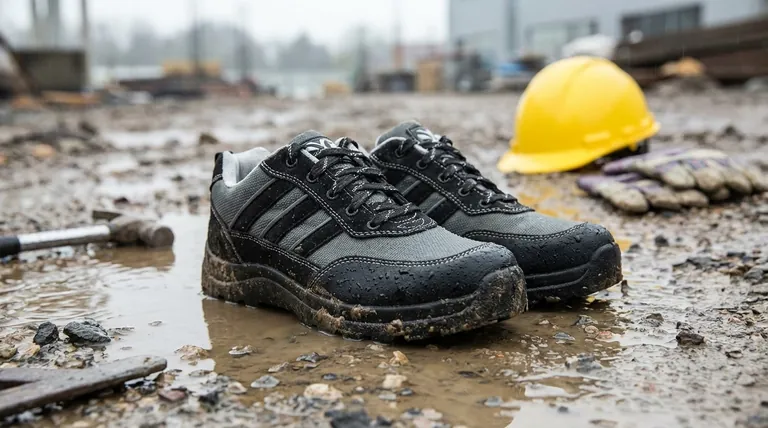The primary drawbacks of rubber shoes are their lack of breathability, a rigid fit that doesn't conform to your foot, and their unsuitability for formal or professional settings. Because rubber is non-porous, it traps heat and moisture, which can lead to discomfort and sweat buildup during extended wear.
While rubber footwear offers unmatched waterproofing and durability for specific tasks, these benefits come at the direct cost of breathability and long-term comfort, making it an unsuitable choice for everyday, all-day use.

The Core Problem: Lack of Breathability
The fundamental limitation of rubber as a footwear material is its inability to breathe. This single property is the source of its most significant drawbacks.
How Rubber Traps Heat and Moisture
Unlike natural materials like leather or canvas, rubber is a non-porous polymer. This means it creates an impermeable barrier that prevents both water and air from passing through.
While this is excellent for keeping rain out, it also means that the heat and sweat naturally produced by your feet have no way to escape.
The Impact on Foot Health
This trapped heat and moisture create a warm, damp environment inside the shoe. Over several hours, this can lead to significant discomfort and a feeling of clamminess.
Constant exposure to this environment can also contribute to foot odor and other moisture-related skin issues, making rubber shoes a poor choice for continuous, daily wear.
Comfort and Fit Considerations
Beyond breathability, the physical properties of rubber create challenges for comfort, especially when worn for long periods.
A Rigid, Unforgiving Fit
Rubber does not have the natural pliability of materials like leather. It does not stretch, soften, or mold to the unique shape of your foot over time.
This results in a static, one-size-fits-all fit that can lead to pressure points or chafing, as the shoe cannot adapt to your foot's movement.
The Feel of All-Day Wear
The combination of a rigid structure and a non-breathable environment makes rubber shoes feel heavy and restrictive during prolonged use. What feels protective for an hour in the rain can feel oppressive after a full day.
Understanding the Trade-offs: Style vs. Function
The choice to wear rubber shoes is almost always a decision to prioritize pure function over other considerations like style or versatile comfort.
The Aesthetic Limitation
Rubber footwear is overwhelmingly associated with utility and casual, rugged use. Materials like rubber boots or clogs are not considered appropriate for business, formal events, or any occasion demanding a more refined look.
Their appearance clearly signals function—think gardening, rain, or heavy labor—rather than professional polish.
When Function Trumps Form
The drawbacks of rubber become acceptable trade-offs in specific scenarios. In wet, muddy, or hazardous work environments, its durability and waterproof nature are non-negotiable benefits.
In these contexts, the goal is not all-day comfort but short-term protection from the elements, making rubber the ideal material for the job.
Making the Right Choice for Your Needs
To select the right footwear, you must align the material's properties with your primary goal.
- If your primary focus is all-day comfort and foot health: Opt for breathable materials like leather, canvas, or modern synthetics with mesh panels that allow moisture to escape.
- If your primary focus is protection from wet or harsh conditions: Accept the drawbacks of rubber, as its waterproofing and durability are superior for short-term, demanding tasks.
- If your primary focus is formal or business style: Choose traditional materials like polished leather, as rubber lacks the necessary aesthetic for professional settings.
Ultimately, understanding a material's inherent limitations empowers you to choose the right tool for the task at hand.
Summary Table:
| Drawback | Key Impact | Ideal Use Case |
|---|---|---|
| Lack of Breathability | Traps heat and moisture, causing discomfort and odor | Short-term waterproof protection (e.g., rain, mud) |
| Rigid, Unforgiving Fit | Does not mold to the foot, leading to pressure points | Activities requiring durable, protective footwear |
| Limited Style Versatility | Not suitable for formal or professional settings | Casual, rugged, or utility-focused environments |
Need durable, purpose-built footwear without compromising on quality?
As a large-scale manufacturer, 3515 produces a comprehensive range of footwear for distributors, brand owners, and bulk clients. Our production capabilities encompass all types of shoes and boots, engineered for specific applications. Whether you need specialized rubber footwear for harsh conditions or breathable alternatives for all-day comfort, we deliver solutions tailored to your market.
Contact our team today to discuss your production needs and discover how we can enhance your product line.
Visual Guide

Related Products
- Durable Rubber-Soled Utility Shoes for Wholesale & Custom Brand Manufacturing
- Premium KPU Athletic Safety Shoes for Wholesale
- Wholesale Breathable Training Shoes Custom Athletic Footwear Manufacturer
- Wholesale Durable & Breathable Training Shoes for Custom Brands
- Durable Canvas Work Shoes with Rubber Lug Sole | Wholesale Manufacturer
People Also Ask
- What historical breakthrough in 1844 contributed to modern shoe sole manufacturing? The Vulcanization Revolution
- What are the benefits of rubber work shoes? Unbeatable Protection for Wet & Demanding Jobs
- What are rubber soled shoes? The Ultimate Guide to Durable, All-Weather Footwear
- What is vulcanized rubber and why is it used in products? The Key to Durable, Flexible Footwear
- What are the main applications of vulcanized rubber? Unlock Durability for Tires, Footwear & More



















